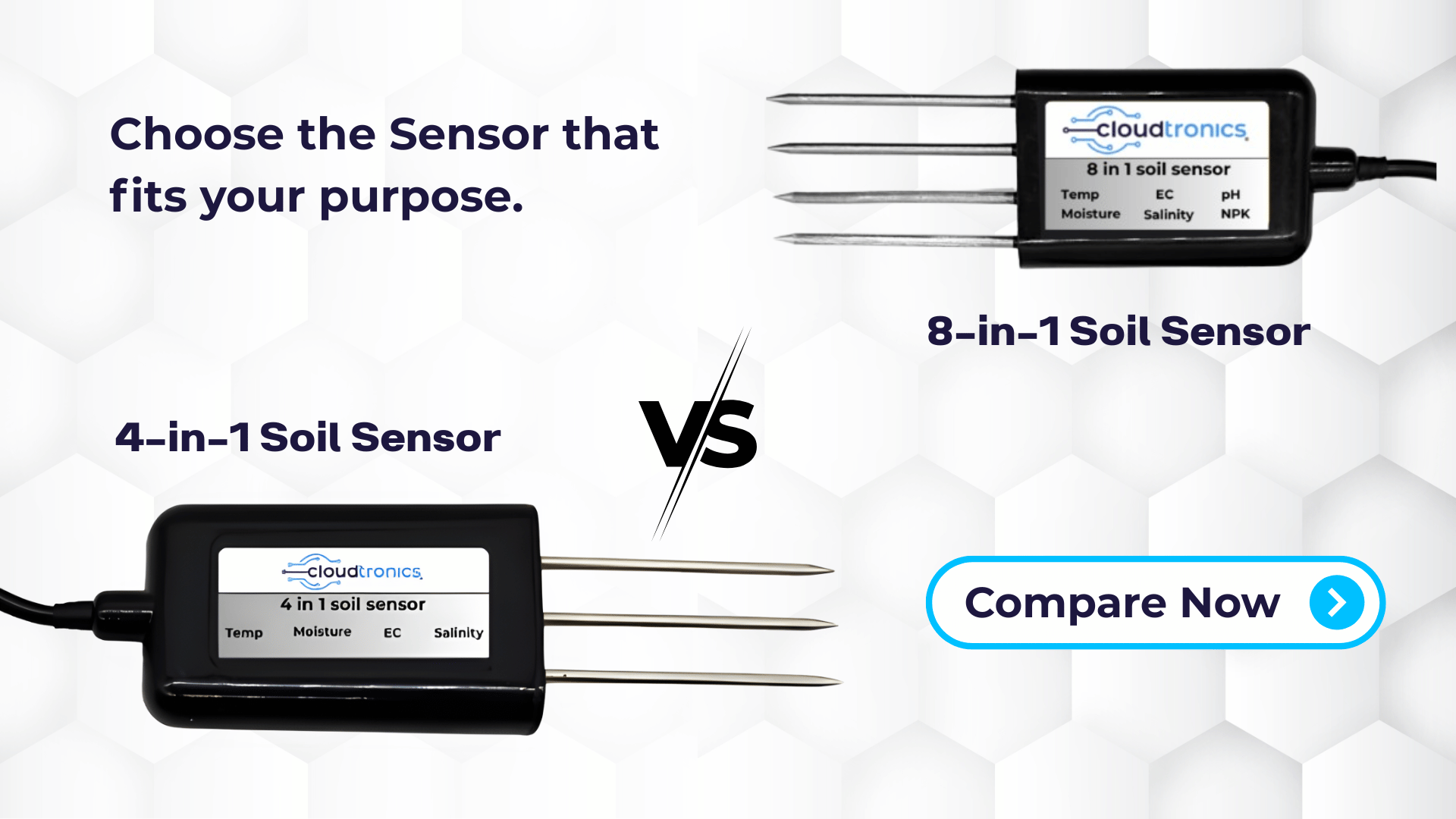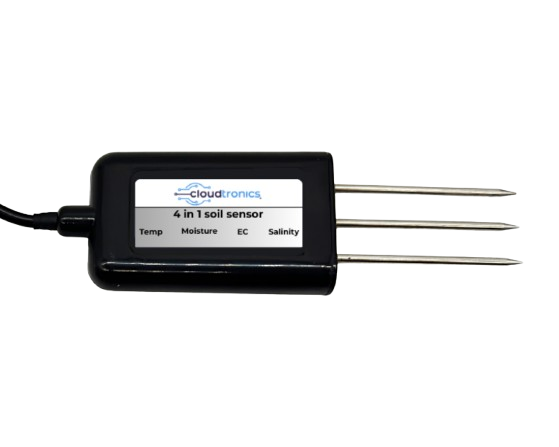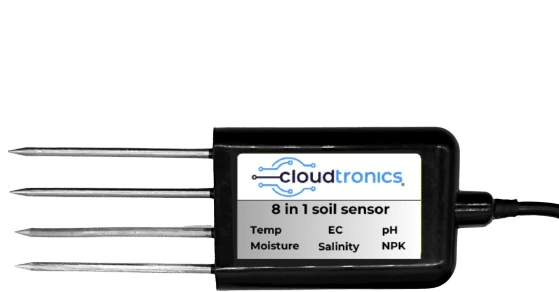
Imagine you could “see” what’s happening under the ground — moisture levels, acidity, nutrients — in real time. That kind of clarity helps you irrigate smart, feed plants just right, save costs, and boost yield. That’s exactly what a soil sensor does. In this guide, We’ll explain what a soil sensor is, key features, advantages, and help you decide between a 4-in-1 or 8-in-1 sensor with real numbers from Cloudtronics’ models. Stick around — by the end, you’ll know which one fits your setup best.
What Is a Soil Sensor?
A soil sensor is a device you place in or under the soil that measures various parameters important for plant growth. These parameters typically include soil moisture, temperature, electrical conductivity (EC), salinity, pH, and nutrient levels (like nitrogen, phosphorus, potassium or NPK).
Sensors report data in real time so you can monitor soil health continuously. This is far better than doing manual sampling, which is slow, labour-intensive, and gives you only occasional snapshots.
Key Features to Look For in a Soil Sensor
Before buying, ensure the sensor offers:
Multiple parameters measured (moisture, temperature, EC, salinity, pH, NPK etc)
High accuracy & resolution
Fast response / low stabilization time
Durability and waterproofing (e.g. IP68 rating)
Stability and corrosion resistance for long-term buried use
Compatible outputs / communication (wired: RS485, 4-20 mA, voltage; or wireless: LoRa, WiFi, 4G, etc)
Ease of installation (probe design, plug-in parts)
Cloud / software support for data access and analytics
We’ll see how the 4-in-1 and 8-in-1 models from Cloudtronics stack up on these.
Cloudtronics’ 4-in-1 and 8-in-1 Soil Sensor Comparison
Using the specs from the product pages:
4-in-1 Soil Sensor (Temperature, Moisture, EC, Salinity)
Measures 4 parameters: moisture, temperature, EC, salinity
Temperature range: –30 °C to 70 °C; accuracy ±0.2 °C
Moisture: 0–100 % (volumetric), ±2 % accuracy
EC: 0–20,000 µS/cm, salinity: 0–10,000 ppm
Outputs: RS485 / Modbus-RTU, also optional wireless (LoRa, WiFi, 4G)
Durability: sealed, corrosion resistant, IP68 rated

8-in-1 Soil Sensor (Temperature, Moisture, EC, Salinity, pH, N, P, K)
Measures 8 parameters: adds pH and nutrient content (N, P, K) to the 4 above
Temperature range: –40 °C to 80 °C; pH range: 3–9; NPK up to 1999 mg/kg
Accuracy: moisture ±2 % (in 0–50 %), EC ±3 % (0–10,000 µS/cm), pH ±1 pH unit, NPK ±2 % FS
Durability: sealed, corrosion resistant, IP68

4-in-1 vs 8-in-1: Which One Should You Choose?
Let’s compare them across key axes:
| Feature | 4-in-1 | 8-in-1 | Verdict / When 8-in-1 is better |
|---|---|---|---|
| Measured parameters | 4 | 8 | If you care about pH and nutrients (NPK), go 8-in-1 |
| Complexity & calibration | Simpler | More complex (nutrient sensors need calibration) | For beginner or simpler use, 4-in-1 is easier |
| Cost | Lower | Higher | 8-in-1 has premium cost |
| Data richness | Good for moisture, salinity, temperature | Full soil health picture | Use 8-in-1 for advanced precision farming |
| Maintenance | Less maintenance | More (nutrient probe drift, pH cleaning) | If you want low upkeep, 4-in-1 safer |
| Use case | Irrigation control, salinity monitoring | Research, detailed nutrient management | Choose based on your goals |
Our Recommendation: If you’re managing a garden, small farm, or doing basic irrigation control, a 4-in-1 sensor gives you most of what you need with less fuss. But for commercial farms, greenhouse operations or precision agriculture, 8-in-1 gives you a fuller soil picture and better decision power.
Advantages of Using a Soil Sensor
Using a soil sensor gives you:
- Better water use efficiency — avoid overwatering or underwatering
- Cost savings in fertiliser and energy — know exactly when and how much to feed
- Healthier crops — maintain optimal soil conditions continuously
- Early problem detection — detect salinity build-up, pH drift, nutrient deficiency
- Data-driven farming — use collected data to refine planting, irrigation and fertilisation strategies
These pay off especially when scaled over large areas or high value crops.
Where to Buy + Why Choose Cloudtronics
Buy Direct from Cloudtronics
Why Buy from Us
Cloudtronics isn’t just another online store — we’re Australia’s trusted IoT and sensor technology provider. Here’s why professionals prefer us:
🇦🇺 Local Australian Support: Talk to real engineers, not call-centre scripts.
⚡ Fast Shipping: Products ship directly from Australia for minimal downtime.
🔒 Genuine Quality: Industrial-grade sensors, tested for Australian conditions.
🔗 IoT Ready: Compatible with Cloudtronics gateways and NodeMate platforms.
🧠 Expert Guidance: We help you pick the right sensor setup for your application.
🌐 Global Reach: Worldwide shipping for research institutions and farms abroad.
If you want dependable sensors with real-world support, Cloudtronics is the name you can trust.
Final Thoughts & Recommendations
Don’t buy the most advanced sensor by default — match to your needs.
If you only care about moisture, temperature, salinity — a 4-in-1 soil sensor is often enough and maintenance is less intensive.
If you have the budget and need deeper insight (pH, nutrient levels), go for the 8-in-1 sensor.
Always check long-term durability, communication options, and software support — a sensor that fails in the field is worse than no sensor.

